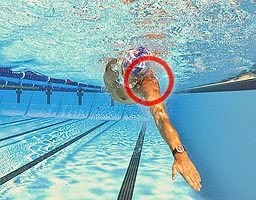Swimmers Shoulder
Swimmers shoulder is an inflammatory condition caused by the mechanical impingement of the soft tissues against the coracoacromial arch. This condition is often seen with the freestyle stroke due to its repeated overhead motion. Swimmers often develop shoulder pain as they push harder to go faster and further. This pain may be caused by two different locations of impingement within the shoulder joint.
The first impingement is seen during the pull-through phase of the freestyle stroke. The phase begins when the hand enters the water and is completed when the hand has finished pulling the water and begins to exit. If the swimmer’s hand enters the water across the midline of the body this places the shoulder in a position of horizontal adduction known as crossing over. This position causes a mechanical impingement of the long head of the biceps against the anterior part of the coracoacromial arch.
The second impingement may be seen during the recovery phase of the stroke. This phase includes the hand as it is exiting the water and until it re-enters. This impingement occurs when the rotator cuff muscles are no longer working efficiently due to the fatigue of the swimmer. It becomes more and more difficult for the swimmer to lift their arm out of the water. The mechanical stress impinges the supraspinatus muscle between the head of the humerus and the middle/posterior aspects of the coracoacromial arch.
Why does it happen?
Swimmers will develop shoulder pain for many reasons. Poor technique, which can be corrected or improved by a swimming coach, is a major factor – as seen with the first type of impingement. Over training, by doing too much too soon plays its part in the equation as well. As the muscles fatigue they work at a less efficient level. This causes the muscles to work harder in a weakened condition and perform more strokes to cover the same distance. It’s a good idea to incorporate some backstroke into your warm-up and cool down to make use of the opposing muscles groups. This will help keep the shoulders back in a more neutral position by strengthening opposite muscles, and will help reduce the chance of an impingement from occurring.
How can we treat it?
The only way to determine which soft tissues are at fault is through ‘feeling’. At Back to Health Wellness Centre the health practitioners have the palpation skills to identify the local adhesions for optimal treatment. Treatment modalities include chiropractic care, Active Release Technique, massage, stretching and strengthening programs.
If you have any further questions either about swimmers shoulder or the services offered at Back to Health please don’t hesitate to email us at: Dr.Rodwin@Back2Health4you.com


